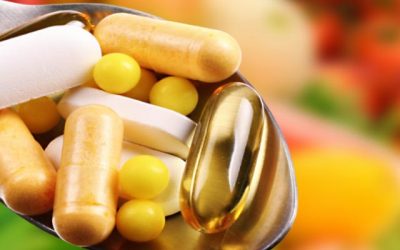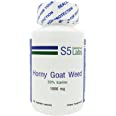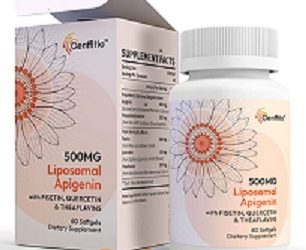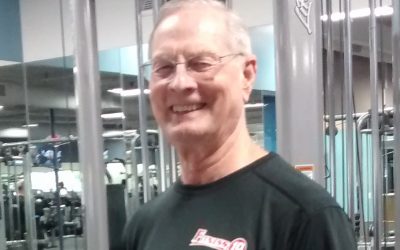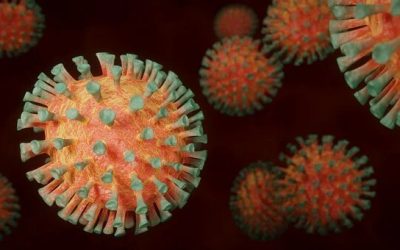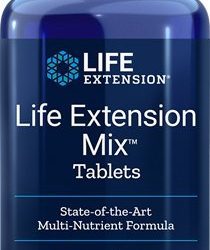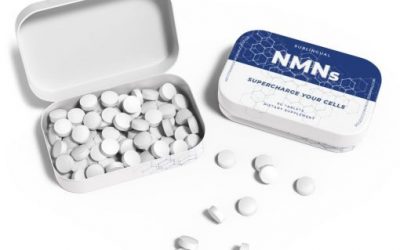Supplements
Supplements
Strategy: Use Science-Based Supplements to Counteract Functional Losses of Aging; Move Better, Think Better, Feel Better!
Why You Should Supplement NMN
Nicotinamide Mononucleotide (NMN), a naturally-occurring molecule, has garnered attention for its potential anti-aging properties. Let’s delve into the benefits of NMN for seniors: Cellular Energy Production: NMN is a precursor to nicotinamide adenine dinucleotide...
Icariin and Longevity
A recent study (references below) brought to mind that the wide ranging benefits of Icariin on health and function extend to longevity. I take the stuff, from S5 Labs, it is an extract of Horney Goat Weed standardized to 50% Icariins. I take 3 capsules per day; one in...
Apigenin – A Promising Compound found in Chamomile and Parsley can Greatly Improve Health
I started looking (yet again) for ways to improve my sleep; to fall asleep faster and make sleep more restorative. Chamomile is noted for relaxation so I was looking for a stronger extract of chamomile or at least the sleep-inducing part of it, thought to be a...
Kidney Function Improvement Related to Boosting Klotho Production
I have long-time friend who has experienced failing kidney function over the years. Recently he reported he was on a transplant list and his GFR had fallen to 6%. I had been researching Klotho, the natural protein expressed primarily in the kidneys, and has strong...
Update on Potential Prostate Cancer Treatement
On September 18, 2019 I had an MRI that found two suspicious loci in my prostate, one of which was diagnosed as likely stage 1 Prostate cancer and the other as transitional, I chose to try an underground approach shown to be selective at killing cancer cells via 4...
Could We Kill this Epidemic in a Month?
The world has been dealing with this Corona virus since late December 2020, and China before that. Data on the severity of outcomes has been gathered from around the world, showing that severity is highly dependent on Vitamin D status. We in the US typically use the...
Life Extension Mix -Updated 2020
Supplement Facts Serving Size 8 tablets (per day) Servings Per Container 30 Amount Per Serving Vitamin A (as beta-carotene, acetate) (5,000 IU) 1500 mcg Vitamin C (as calcium ascorbate, ascorbic acid, ascorbyl palmitate, magnesium ascorbate, niacinamide ascorbate,...
Vitamin D3, Magnesium, Vitamin K2 Critical for Longevity & Senior Fitness
Vitamin D3 is a rampant deficiency in sun-phobic men and women; the further north you live (above the equator), the more likely to be deficient. Levels below 30 ng/dl cripple the immune system. Optimum number keeps going up; shoot for 70 ng/dl. That takes 5000 IU -...
Training at Fitness19 in Simi Valley
In December I was hired as a trainer at the new Fitness19 Gym in Simi Valley CA. If you're tired of sliding down-hill toward infirmity, let me help you on a new path to strength and stamina with a renewed outlook on growing older with class and grace. I guide you...
Update on My NMN Body Transformation Project
I completed the 3 months of taking Nicotinamide Mononucleotide (NMN) at 1 gram/day at the end of October. I'm quite pleased with the results, but I wish I had done it at a time when I could have used the gym and weight training to to make the progress better visually...
Supplements for Optimal Aging – Part 1: Introduction
With age comes decreased capacity to repair cellular damage, to digest foods completely, to produce energy in our mitochondria, to recover from exercise, to take in and use oxygen, to circulate blood, to repair cartilage, etc. Supplements are the secret to getting around these limitations.
The primary issue is to find supplements known to positively impact and improve whatever limitation is observed. If you think they are generally a waste of money, you need to understand the amazing difference the right nutrients can do for our aging bodies. Today’s foods are stripped of many critical nutrients and loaded with other elements that speed aging, depress the immune system and impede cellular activity.
There is a huge array of supplements on the market – some wonderful,some dangerous, some useless. We try to cut through the hype and show you which are powerful boosters for overcoming age-related limitation. However, the best source of technical information on supplements is http://examine.com – this is where to go to thoroughly understand what you are thinking about putting into your body; bookmark the site and use it wisely. Supplements we promote fall in the following areas:
- Enzymes – to completely digest food, eliminate gastric distress.
- Probiotics – to keep the digestive system populated with health-creating organisms, control blood lipids and regulate the immune system.
- Anti-oxidants – to retard aging, reduce inflammation, fight cellular and DNA damage and promote healing.
- Vitamins and minerals – to provide optimum nutrition for our aging bodies; making up for diminished nutrient levels in modern agriculture’s foods.
- Essential Fatty Acids – to replace those lost in food processing, needed for the proper function of every cell in your body. They are very important for holding down inflammation in all out tissues.
- Food/Plant Extracts – to allow us to get therapeutic levels of nutrients which can reverse many conditions of aging.
- Bodybuilding aids – that promote lean muscle growth, fat reduction, strength enhancement, endurance, energy production, exercise recovery, improved blood flow and blood pressure.
- Products that improve hormone production and balance – to recover capabilities you thought were gone forever.(Some overlap with Bodybuilding supplements exist here)
- Much, much more.
A Great source for learning the science behind the supplements I use is Life Extension Foundation and life Extension Magazine.
Supplements for Optimal Aging – Part 2: Supplements to Make Digestion Work at Every Age
The first place to start is with supplements that aid in the process of digesting food. One of first problems we commonly experience is reduced production of hydrochloric acid (HCl) and Pepsin by our stomachs. The first sign of this is indigestion or heartburn. Older stomachs don’t make as much HCl, and it gets worse with age. So we can’t digest/absorb proteins or minerals as well as the young. Most people notice the problem as heartburn or reflux – the stomach doesn’t empty, a full feeling stays forever, and our stomach contents start leaking back past the lower esophageal sphincter valve. This valve requires a strong acid level in the stomach to get the ‘stay closed’ signal; when it leaks we get heartburn. The real answer is to take Betaine HCl with meals to make sure we quickly digest what we eat and then the stomach empties as it should – end of problem. Taking antacids or acid blocking drugs may reduce heartburn symptoms, but they only make the absorption problem worse. In essence, they guarantee malnutrition in the long run. That’s why we see an increase of broken bones, crippled immune systems and other diseases associated with aging in long-term users. Buy a big bottle of Betaine HCl with Pepsin (I use “Swanson Vitamins” brand most of the time) and take them with every meal; start with one and increase as needed. It is important to take these with the meal, so the acid gets buried in the meal, not well before, not well after.
Along with HCl with pepsin, you will find enzyme complexes designed to aid digestion. They contain combinations of enzymes involved in digestion – for taking apart foods, breaking them down into molecules which can be absorbed along the length of the intestines. Look for products with proteases, including pancreatin, bromelain and papain (these break down proteins), amylase (digests starches), lactase (breaks down milk sugar), lipase (digests fats) and cellulase (breaks down vegetable cellulose fiber). I typically use the Swanson Brand for this as well. Using these will normally eliminate gas formation, speed digestion and improve bowl motility and regularity. Heartburn will be a thing of the past, as long as you mind the important rule of never eating within three hours of going to bed.
The next important supplement group for optimum digestive function is the use of Probiotics. Inflammatory bowl diseases are increasingly common these days, and most of the problems stem from imbalance of the natural flora (bacterial and fungal populations) that makes their home in our intestines. There are over 400 bacterial and fungal species that symbiotically function within our digestive tract, and they are an important part of our immune function as well as performing many digestive functions. They normally outnumber our own body’s cell count, and their chemical signaling is a major part of our own gene expression. In other words, the bacteria in our gut are capable of directing which of our genes are turned on or off, including genes that promote inflammation throughout the body.
Several factors impact these bacterial/fungal populations. Sugar, for example will feed an over-bloom of Candida Albicans, causing bowl inflammation and vaginal yeast infections in women. Antibiotics drastically alter these populations and kill off most bacterial species while letting yeasts and other fugal types become dominant. Excessive alcohol has a similar effect. But the primary influence on our gut biome makeup is our diet; the foods we chose to eat also feed the gut biome and control its population. Eating real food as discussed in our Nutrition Category is the best way to keep the bugs in balance.
We can restore optimal population balance by taking probiotic supplements, eliminating a plethora of negative conditions caused by the wrong germs getting out of control.
Of primary importance are the Lactobacillus and Bifidobacterium strains, which are both introduced to us by our nursing mother, so are with us from birth. These set the tone for others that follow as soon as we encounter the world around us. Most of these various cultures have some positive function in our system, but when any imbalance occurs, there can be a negative impact on health. My favorite product for restoring sanity to my gut is Dr Steven Langer’s Ultimate 16. I have used this to stop food poisoning in its tracks on more than one occasion. You can find many products on the market, but I like the wide variety of bacterial strains in this one and the prebiotic FOS included.
Some of our natural bacteria are called Gram-Negative bacteria (they include bacteria like E-coli, Salmonella, Pseudomonas, Helicobacter, Legionella, etc – potential bad guys). If these get out of control they become highly toxic to us. They constantly shed part of their cell walls, releasing lypopolysaccharide (LPS). High levels of LPS in the blood put us into septic shock and can kill us in hours, but lower levels from overpopulation of these bacteria just poison us slowly, causing inflammation (our immune system’s response to invaders) and promoting a broad array of disease state, including heart disease, organ failures and cancer. It is important to manage our bacteria by feeding the good guys and keeping them happy, so they restrain the potential bad guys.
Supplements for Optimal Aging – Part 3; Nutritional Supplements
The first step is to supplement those nutrients that are, in this age of industrial farming and food ‘production’, less and less available; missing or far lower in content than the same food raised two centuries ago would have embodied. The key factors are:
- First, minerals – the soils used for industrial farming grow more devoid of minerals with every crop.
- Second, because of soil quality changes, important plant chemicals are lower in today’s crops, engineered to be larger, to hold up better in shipping, and picked before truly ripe, they are far less nutritious as those of yesteryear.
- Third, meats, poultry and seafood are raised on artificial feed that is not even close to their natural diet and therefore they are lacking many nutrients compared to 200 year ago. Some examples are the inferior omega-3 fat content of industry-raised animals, including chickens that never see a bug on real dirt, eggs they lay with pale yellow yolks, salmon eating a soy-protein feed when they should be eating little fish, and beef raised on grain rather than grass.
Many of our major health issues start from a diet with a badly balanced ratio of omega-6 versus omega-3 fats; a ratio that should be about 1:1, but today is closer to 20:1. Why? Omega-3 fats go rancid very quickly and start to smell like rotting fish. There is almost no shelf life for these fats. They are needed for life, but the food industry can’t live with them and do business as usual, so they strip them out to gain shelf-life. These elements that used to be abundant in everyone’s groceries are now greatly reduced, and insuring complete nutrition is tougher today. Where do we start? Start with the understanding that, as I said above, today’s food is not yesteryear’s food, and supplement diet with a full-spectrum, multi-nutrient formula that includes vitamins, minerals and extracts from as many superfood sources as possible.
My choice is Life Extension Mix from Life Extension Foundation. I’ve used it for decades. It is constantly updated to incorporate the latest nutritional technology; when enough evidence shows that a nutrient improves health and longevity, it is added to the formula. I have taken multivitamins from childhood, and reviewed them over the years. I’ve evaluated most of the products on the market, and nothing comes even close to the breadth/completeness of this product. It’s my baseline supplement upon which I depend for complete nutrition. It requires taking 8 good-sized tablets per dayl, but I rarely eat a meal without them. It also come in capsules and powder forms if you can’t swallow big tablets. It is, and will likely remain, my baseline supplement for insuring complete nutrition on a daily basis. The time to start taking a comprehensive formula like this is today, regardless of age, the younger the better, but today is the best we can do. Check out Life Extension Mix here.
The mainstay of my supplement program continues to be the exceptional products from Life Extension Foundation. The research behind their products is the most comprehensive in the business. When the science show that a substance enhances human health without negative side effects, they formulate a product and make it available to the members and the public. Most of the supplements I take are from LEF (about 15 of them currently). Go to the site, check out their membership program and products.
As we age supplementation needs change, generally increasing as we need to make up for functions of our bodies that are throttling back with time. So be attuned to declining processes, particularly repair processes, which start showing up with age and add appropriate supplements as necessary to keep your body fit enough to live as you wish.
Supplements for Optimal Aging – Part 4: Essential Fatty Acids
Strictly speaking there are only 2 essential fatty acid that we cannot make and must get from diet; alpha linolenic acid (an Omega-3 fatty acid) and Linoleic acid (an Omega-6 fatty acid). From these two, we can synthesize (when we are young) all the types of fats our body needs, but not in the quantities needed for optimal health. We depend upon eating considerable amounts of dietary fats for real health. Today we have three strikes against us:
- Foods are farmed in ways that reduce omega-3 content (like commercial fish farming)
- Foods have these fats stripped out to gain shelf life
- We have been told for the last 5 decades that fats are bad
Omega-3 fats are critical to supplement; our bodies depend on them for cell wall and membrane function and for suppression of inflammation. In youth, the body can typically manufacture all the required omega-3 fats needed if it gets ample amounts of the essential fatty acid Alpha-Linolenic Acid (ALA). A top source for ALA is flax oil, but it must be in a black bottle, cold pressed under nitrogen atmosphere, and refrigerated after pressing. I like Barlean’s Flax Oil, but I only buy it if it is displayed in a refrigerated case. I usually take it by spoon in the morning (it should have a mild nutty flavor – anything close to tasting like paint thinner is long gone) or mix a tablespoon with my Greek yogurt, berries and chopped nuts for breakfast. A second essential fatty acid is Linoleic Acid (LA), an omega-6 fat from which the body can build other omega-6 fats. It is important to grasp that both of these essential fatty acids are required for life, and it is important that they be available in a ratio of about 1:2 (omega-3:omega-6). These are called ‘essential’ because we can’t make them internally – we have to consume them.
The issue today is that all the refined oils you see on grocery shelves (corn, safflower, canola, peanut, etc, colorless oils in clear bottles) are devoid of omega-3s and high in 0mega-6s and are very pro-inflammatory. So, don’t use any refined oils in your diet – get them out of the pantry and watch for them in things like commercial salad dressings and manufactured products. As we age, the conversion of ALA and LA to other needed fats is slowed, so it is best to supplement with fish oil or a product that supplies those fats as well as ALA. The known important fats are DHA, EPA and GLA. One product I like is made by Wellness Recourses and is called Leptinal – click here for product details and function. Leptinal, has therapeutic (fixes stuff) levels of all three fatty acids, plus pomegranate extract, plus citrus flavones and tocotrienols (a powerful form of vitamin E) for vascular health. These fats make our blood vessels flexible (helps blood pressure), help us burn body fat for fuel and make our brains work right – we can’t live without adequate amounts in our diet. If you are trying to reverse metabolic syndrome or diabetes then this is the supplement for you.
Here are some supplements that are proven to slow the aging clock, and do it by mimicking caloric restriction. In animal studies (including primates) caloric restriction can add about 30% to youthful lifespan, but you have to nearly starve to do it. But studies have shown that resveratrol, quercetin and vitamin D also turn on these genes. So if we can add up to 30% to our healthy years by taking daily doses of these three items, it seems wise to do so. The dose for resveratrol used in studies to get these results is about 250 mg/day (I use LEF’s Optimized Resveratrol 250 mg). The dose for Quercetin is about 1500 mg/day (I get mine from Wellness Resources). You want to use these in addition to not overeating, not so you can get away with overeating.
Vitamin D3 is now available everywhere and recommendations keep going up as benefits are discovered at higher levels. I currently take 15000 IU/day because it is winter (insufficient sun to make it in our skin in California). I have my blood tested (25-OH vitamin D test) to determine the results of my dose, and I am at 77 ng/ml of blood, with optimum now thought to be 70-90 ng/ml. It took me a year of supplementation at that dose to get me to my current levels. Vitamin D is vital to proper immune function – it makes the immune system smart about what it does battle with, and so it prevents much of the unnecessary inflammation that develops with age. This is perhaps the most bang-for-your-buck you can get with any single supplement – everyone should be using this and measuring their blood levels to get to optimal values. (Update: I found in summer of 2014 that my levels stabilized at about 100 ng/dl with only 5000IU/day – I’ll see what happens this winter, but my body seems to have improved its ability to generate or absorb vitamin D with time.) Life will vastly improve with it.
Nutritional science has been stunned by the sweeping benefits of optimal vitamin D levels – it allows virtually every system of the body to work correctly, and deficiencies cause the same systems to go haywire. We were designed to live in the sun so we make lots of vitamin D, and hiding from it is very unhealthy. But now you can buy it in a bottle – isn’t technology grand? Vitamin K2 works with D3 as a marshal of calcium into bones and teeth and out of soft tissues and joint spaces, so bone health requires both D and K2. That is why I settled on Life Extensions Vitamin D with K2 and Sea-Iodine as my only source. Why Iodine? Its required for the health and function of most of our endocrine glands, especially the Thyroid.
Supplements for Optimal Aging – Part 5: Antioxidants for Optimal Aging
Here are some antioxidants that should be a part of your strategy to minimize the effects of aging.
Alpha-Lipoic Acid is an antioxidant that is both fat-soluble and water-soluble, and crosses the blood-brain barrier to work in all tissues. It can minimize the neurological damage from a stroke, and is thought to retard the progression of Alzheimer’s disease (AD). It also lowers blood sugar levels and improves insulin sensitivity in type-2 diabetes and metabolic syndrome, preventing damage from glycation. The R-lipoic acid form is what the human body produces, and better supplements use R-dihydro-lipoic acid, which is immediately active upon ingestion, another preferred form is Sodium R-Lipoic Acid.
Coenzyme Q10 (preferably the Ubiquinol form) is another must-have antioxidant that works in our mitochondria – the energy factories which power all cells of the body – and greatly enhances energy production. In animal studies, high levels of CoQ10 have been found to retard aging markers and to reduce fatigue significantly. The body’s production of CoQ10 is hampered by all statin-based drugs (Lipitor, etc.) because it is synthesized from cholesterol. If you use any of the statin drugs you absolutely should be taking supplemental CoQ10. The ‘rare but serious’ side effect spoken of in the statin drug commercials is caused by mitochondrial death due to reduced levels of CoQ10. It is not reversible, and leads to a nasty death. The Ubiquinol form is better absorbed and assimilated and is about 8 times more effective in facilitating energy production than the older Ubiquinone at the same dose. Its function as an antioxidant is far more effective as well. I use the 100 mg Qunol brand available at Costco – great bargain.
Pomegranate juice or extract is another effective antioxidant product you can add to your diet. A study cited in July/07 Life Extension magazine showed a 35% reduction in carotid artery intima-media thickness (IMT) (basically plaque) after consuming 1.7 ounces of the straight juice every day for 1 year. The same group saw a 21% reduction in systolic BP in that period (because their arteries became more flexible). Why wouldn’t you drink this for life? Costco sells unsweetened ”Naturally Pomegranate” brand juice, with 1 Oz = antioxidant equivalent to 15 pomegranates. Berries in general are loaded with powerful health-building antioxidants and other factors, and should be a significant part of our diet.
Glycation Blockers – Reducing Blood Sugar and Insulin to Healthy Levels When blood sugar bumps into proteins or lipids (such as a cell wall component) it sometimes reacts with them and forms advanced glycation end-products (AGEs). This now useless combination stays where it was formed and the damaged structure no longer performs its original function. This is the primary cause of diabetic damage. One of our most important anti-aging strategies is to reduce glycation damage by keeping blood sugar low. Dr. Alan Ingles states that fasting blood sugar above 75mg/dl signifies the beginning of pre-diabetes. The risk of developing type 2 diabetes accelerates with every point above that, and skyrockets above 90. By the time you reach the medical alarm level of 125, the damage has been going on undetected for years. This damage is cumulative with aging and essentially irreversible, so prevention is the only valid strategy for now.
At the top of your strategy list for controlling blood sugar should be the practice of eating modestly, never eating to fullness. For instance; there is no human on earth that biologically ‘needs’ to eat a Subway Foot-long of any kind. A Six-incher is far more the right size for a single meal. Second, eat only three modest meals a day – drinking only water between meals to get a six hour digestive fast between meals – and eating only low glycemic index foods. Drastically reduce sugar and starch intake; delete soft drinks, sugared or diet, from your life. Make desserts a rare treat, and eat only modest amounts of whole-grain breads and pastas. Virtually all breakfast cereals should be replace by real food; try lightly sautéed diced veggies (a variety) scrambled with two or three free-range eggs, or a variety of fresh berries with goat-milk yogurt and some crushed almonds Below are some other products to consider in this fight.
- Beta-glucans are soluble fibers found in cell walls of oats, barley, yeast, bacteria, algae and mushrooms, which have the remarkable ability to improve blood glucose metabolism. If you eat the right whole grain products, you get a good supply of beta-glucans. Most breakfast cereals will be devoid of them, and full of white flower and sugar. There are numerous supplement products on the market that will allow you to add beta-glucans to your food in the form of a powder.
- Alpha-lipoic acid was cited in the first paragraph of this article as a powerful antioxidant, but it also significantly lowers blood glucose and improves insulin sensitivity.
- L-Carnosine is a naturally occurring antioxidant that performs an anti-glycation function in the body, preventing the formation of advanced glycation end-products (AGEs). It also improves metabolic function. Beta-Alanine found in most pre-workout products is a precursor to Carnosine and boosts its levels effectively.
An example of a multi-nutrient product for glucose management is Life Extension’s CinSulin™. I’m a firm believer that products designed with synergistic combinations are much better than trying to find one magic bullet that fixes a problem. That’s the way foods work – as vast combinations of nutrient elements that our bodies know how to use to best advantage. Look for supplements that provide a broad spectrum of ingredients known to minimize these aging mechanisms.
Supplements for Optimal Aging – Part 6: Supplements that fight inflammation
Aging brings a general stiffening of tissues, loss of bone mass and density, shrinkage of the brain, joint cartilage and some organs’ size, and a slowing of energy production in all body cells. Part of this is because our immune system, an army of immune cell types that defend us from invaders, turns on our own tissues and leads to self-inflicted damage. The resulting chronic, degenerative, inflammatory-based diseases produce pain, debilitation and early death; diseases such as atherosclerosis, arthritis, diabetes or a bevy of other ‘itises’, cancer or Alzheimer’s. These are the diseases we want to avoid for life.
The Nature of Inflammation and its Connection to the Chronic Diseases of Aging
The underlying cause for these conditions are proving to be age-related systemic inflammation, largely caused by either chronic over-eating or eating what is not real food. In animal studies and in human experience we consistently see that being under-fed results in almost complete elimination of these inflammation-based diseases. Over-eating leads to accumulation of body fat, along with hormonal changes that lead to even better fat storage capability.
The fat we hold around our midsection is proving to be a primary source of inflammation. Recent studies show that excess abdominal fat attracts and harbors large populations of immune cells (macrophages) that spew out inflammatory cytokines such as interleukins (IL-6, IL-8), and TNF-a (tumor necrosis factor-alpha). These chemical messengers cause inflammation in remote tissues throughout the body. In other words, they tell the immune system to come over here (wherever) and kill something. The bullets used by immune cells to combat invaders are essentially free radicals of various kinds. Normally, they go about their protective work by targeting invading bacteria and viruses, shooting out these charged molecules to damage their structure, and then calling in others to eat them and digest and eliminate their materials.
With aging, there is a general, systemic increase of inflammation that results in the immune system attacking our own cells in a similar manner. Over time this damage manifests itself as those outward signs of aging, as well as the leading killers heart disease, cancer and dementia, along with diabetes, joint destruction and several autoimmune diseases. The master controller of inflammation is a chemical known as Nuclear Factor Kappa Beta (NFkB). Found in the interior portion (cytoplasm) of every cell, NFkB is normally bound to inhibitory proteins that keep it in an inactive state. When cells are exposed to infectious invaders or stressors such as free radicals or environmental toxins (like cigarette smoke), NFkB is activated.
NFkB then travels to the cells’ command center, the nucleus, where it binds with DNA to turn certain genes on or off. By interacting with more than 400 different genes, NFkB activates the body’s blueprints for inflammation. These gene products are used to coordinate further inflammatory immune responses in the body. When our cells become damaged by free radicals or by glycation as in diabetes, NFkB is likewise called into action. Cellular damage is cumulative throughout life, and is a large factor in the rise of inflammation with age. That’s why we want to eat anti-inflammatory foods and avoid those that promote cellular damage. That’s why we use antioxidant supplements and keep our blood sugar under control. Beyond that, the next strategy to moderate age-related inflammation is to use supplements that directly control and suppress NFkB.
Nutrients and Supplements That Inhibit NFkB
At the top of this list is vitamin D3, a powerful hormone that moderates inflammation in all tissues by controlling NFkB activity. We need blood levels of vitamin D to be 70-100 ng/ml for optimum immune function, so request the 25-OH-vitaminD Test from your Doctor, determine your current levels and supplement (or get enough sun) to get them in that range; there is no better bang for the buck. More on Vitamins D, K and Iodine
Antioxidants are known to reduce inflammation as well as cancer risk. NFkB is the common link to both processes. Vitamins E (in all 8 forms) and C have been shown to reduce inflammatory cytokine production that is a consequence of NFkB activation. N-acetylcysteine (NAC) and S-adenosyl-methionine (SAMe) exert anti-inflammatory effects by reducing NFkB activation. The potent antioxidant alpha-lipoic acid (ALA) binds to and inhibits NFkB in the cell’s nucleus. Zinc may also exert its antioxidant effect by reducing NFkB activation.
Omega-3 fatty acids reduce inflammation. It is now clear that these effects occur due to inhibition of NFkB activity by eicosapentaenoic acid (EPA), docosahexaenoic acid (DHA), and other essential fatty acids in this class found in fish oil. Flavonoids found in fruits and vegetables are well-established modulators of the immune system’s inflammatory responses. Some of these, the isoflavones, inhibit NFkB and thereby reduce the invasiveness of breast cancers and increase programmed cell death in various human cancer cell lines. Evidence also indicates that isoflavones act by the same mechanism to inhibit bone loss in osteoporosis.
Curcumin has well-established antioxidant and anti-inflammatory effects. The extent to which curcumin exerts these effects by inhibiting NFkB is becoming increasingly clear. Curcumin acts directly within the cell’s nucleus and also acts on substances that activate NFkB. For example, it binds iron and copper in brain tissue, reducing the activation of NFkB that is associated with the production of amyloid beta proteins in Alzheimer’s disease.
Licorice root extracts are among the oldest remedies in Chinese medicine, and have long been used for their anti-inflammatory, anti-viral, anti-ulcer, and cancer-preventive properties. A major component of licorice inhibits NFkB.
Ginger extracts exert anti-inflammatory activity and stimulate cancer cell death by inhibiting NFkB. Clove extract (eugenol) inhibits NFkB-mediated expression of other inflammatory cytokines.
Basil and rosemary extracts, which contain ursolic acid, reduce cancer cell proliferation and tumor progression through NFkB inhibition. Garlic has now been shown to exert its anti-inflammatory and immunomodulatory effects by inhibiting NFkB.
The amazing Pomegranate fruit, and its extracts, protect cells against the effects of ultraviolet B radiation by inhibiting ultraviolet light-stimulated NFkB activation (so you can tan and make vitamin D, but not promote skin cancer). Pomegranate fruit extract also prevents chemically induced skin cancers in mice, reduces arterial inflammation, cleans out plaque and shows promise in reversing osteoarthritis damage by blocking the activation of NFkB in these tissues. Pomegranate extract is the second greatest universal health bargain; supplement with 500 mg/day – it fixes almost everything. More about Pomegranate
Damping down the processes of inflammation is critical for healthy aging. Levels of systemic inflammation drop in a few weeks of under-eating along with trading the intake of anti-inflammatory foods for those that foster inflammation. The foods to increase are organic vegetables, fruits, nuts, wild-caught fish, grass-fed livestock and free-range poultry and their eggs. Those to eliminate are manufactured foods, sodas, refined oils and sugar-based junk foods.
Fight inflammation and rapid aging – eat real foods – forget those that come in a bag or a box, most that come in cans, and those things called desserts. Then, we must move our body – exercise is critical for lowering fat content and building muscle, all of which is critical for minimizing inflammation, to grant us decades of healthy, pain-free senior years.
Hormone Production and related supplements Aging is the primary factor affecting hormone production in both men and women. Both go through a very well understood and predictable life cycle, wherein hormone levels generally decline after reaching maturity, which impacts all other aspects of aging. Men see a steady decline of their primary sex-defining hormone – testosterone – with age, which primarily impacts muscle mass and sexual function, but mental changes occur as well. Women have monthly cycles imposed over a similar age-related decline, but experience a sharp drop in their primary sex-defining hormone – estradiol – during menopause, after which hormone levels become relatively stable. The use of supplements to affect hormone levels and natural hormone replacement is complex enough that we treat the topics separately for both men and women in two other Categories on this site: Hormone Management and Sexual Fitness; The details are there.
My approach to this aspect of aging is this: as long as we can get our own hormone production to stay in favorable ranges, then use supplements to do so, and only then move to hormone replacement, and then only with bio-identical hormones that match the natural balance youthful levels and only with the guidance of a doctor skilled in this discipline.
Supplements for Optimal Aging – Part 7: Addressing Cellular Senescence
Our cells get old after dividing about 10 to 50 times for humans, depending on cell type, then they change characteristics and function and either commit suicide (apoptosis) or just quit functioning (stasis or senescence). Ultimately it is this wearing out that defines our maximum life span, thought to be about 120 years for humans. Several factors can push cells into senescence, but the process is not fully understood, so the known causes may not be the whole story. These include:
- Stress signals
- Telomere shortening
- DNA damage
- Chromosomal scrambling
- Oncogenic changes
There are, however, known strategies that get the most mileage out of our cellular lifespan. Most of the early studies that laid the groundwork for understanding senescence were done in petre dishes or in vitro, whereas more recent studies are answering the question of whether the same process takes place in live animals or in vivo. The life stages that a cell goes through as it originates from a stem cell through specialization, maturation, multiple divisions, and finally to stasis, senescence or cell death is called the cell cycle. The process of cell division is called mitosis, and at each division there is an opportunity for replicative error. Cells make enzymes for DNA repair, wherein some errors can be detected and fixed, but errors do creep in during the life cycle of a cell. If enough errors occur, the cell will enter stasis (reversible under some conditions) or senescence rather than continue to divide.
Senescent cells prove to be a primary source of Inflammation and create a cascade of accelerating aging.
In the past senescent cells were considered dormant and metabolically inert. Recent studies have shown that they secrete a cocktail of signalling chemicals that create local inflammation and induce surrounding cells to join them in becoming senescent, resulting in rapid aging of the surrounding tissues. This is seen in all types of tissues and organs, leading to a rapid decline in function, and now thought to be causative of most of the diseases of aging. This property of senescent cells is referred to as – Senescence-Associated Secretory Phenotype (SASP). Injecting a modest amount of senescent cells into a young mouse (or any animal) will cause it to start aging more rapidly. Killing off senescent cells slows and even reverses aging in old animals, including humans. This is a very cool outcome!
Enter the science of Senolytic Compounds/Drugs:
Recent discoveries of drugs and natural compounds of plants that can selectively destroy senescent cells or coerce them back to dormancy are being revealed every day. Much more is to be explained here soon.
A key factor in a cell entering the senescent state is the loss of telomere length with each division. Telomeres are likened to the plastic ends of shoelaces that protect them from unraveling. Telomeres are found at the ends of DNA strands in chromosomes, and guard against DNA fusing errors during replication. Cells that express an enzyme called telomerase can repair their telomere length indefinitely. All cancer cells manage to turn on telomerase production, thereby managing to stay immortal and divide ceaselessly until they unwisely kill their host. Early thinking was that if we could just turn on telomerase production in our rapidly dividing cells, we could retard the aging process. However, it seems that telomere shortening is a tradeoff against the risk of developing enough errors to allow the development of cancer. Within our DNA there are numerous genes that generate signaling proteins capable of tagging cells for destruction by our immune system; p53 is a signal protein that will order destruction of a cancerous cell. P12 and p16 are proteins that order a cell into stasis independent of telomere length. It is now known that healthy telomeres form loops at their ends which tell our immune system that the cell is healthy. Telomeres that fail to form this loop are thought to be another signal for destruction or decommissioning. So what strategies are known to be effective in keeping cells clocking along doing their job effectively? In the articles that follow in this email, several promising outcomes are discussed, but here are the bottom line strategies and why they seem to work:
Caloric Restriction – turns on longevity genes that keep cells functioning well longer. One of the following articles supports my belief that the primary factor in caloric restriction is actually restriction of glucose and other dietary sugars and starches. Our bodies work best if about 65% of our energy production results from burning fats as our primary fuel. This goes right along with the Leptin Diet strategy that I have been using and promoting for the last year. If you want to shorten your healthy life span, just eat too much too often.
Resveratrol, Pterostilbene and Quercetin – activate most of the same genes as caloric restriction. Anyone wanting to live long and healthy will do well to supplement significant amounts of these. I’m taking 250 mg of resveratrol, 50 mg of pterostilbene and 1500 mg of quercetin daily.
Exercise – yes, there is that all-important word we love to hate, but another of the articles included in this email shows that intense endurance muscular activity turns on telomerase production in muscle cells, prolonging the functional life of our muscles. Exercise is critical to staying strong into advanced age – use it or lose it – a fundamental truth! This study only looked at distance runners, but my bet is that strength training will have exactly the same benefit.
Astragalus – TAT2, a compound in astragalus root, used in Chinese herbal therapy, prolongs killer T-cells’ ability to divide because it ramps up telomerase in these and possibly other cells. The company TA-Sciences makes a modified extract of Astragalus called TA-65 that they show brings rapid reversal of most markers of aging, however, the least expensive version of this compound is from Revgenetics who offers an enhanced version at a much better price. See Enhanced Ta-65 here.
Mitochondrial Food: for the care and feeding of my mitochondria I use Mitochondrial Energy Optimizer with BioPQQ from Life Extension twice a day, every day, without fail. It seems to be working OK so far. A less expensive version is Mitochondrial Basics which I have also used. Yes, we all wear out and eventually die – but for me, later is better. I have lots of fun in this life and having good health is a profound blessing I hope to sustain as long as practical.
Good Living – Frank

